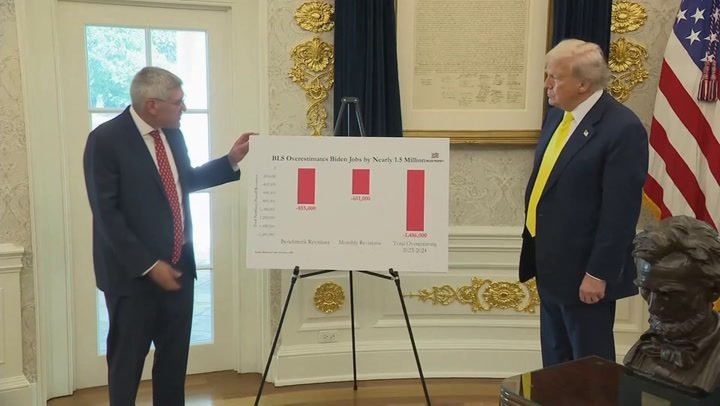If your utility bill looks higher this summer, you are not alone. Electricity costs are up 5.5 percent from last year, and natural gas prices have climbed nearly 14 percent, federal data shows.
Nearly 60 utility companies will raise electricity rates this year. The increases will add more than 38 billion dollars in costs and affect 57 million Americans, according to the Center for American Progress.
President Trump has blamed renewables for the rise. On Truth Social he called wind and solar “THE SCAM OF THE CENTURY!” and promised he would block new clean energy projects.
Experts, however, say demand is the main driver. Rob Gramlich, president of Grid Strategies, explained that new technology is consuming far more energy. “When supply is scarce, then prices go up,” he said.
He added that energy demand was flat for decades, even falling during the pandemic. Once the economy reopened, demand surged. Oil and gas drilling, space heating, and electric transport added more strain.
Russia’s invasion of Ukraine also disrupted global fuel supply chains. That shock added pressure to U.S. markets. Rising use of artificial intelligence has also increased power needs at an unprecedented pace.
Gramlich estimated the nation will need 15 percent more capacity, equal to 120 gigawatts, by 2030. The U.S. Energy Information Administration projects residential electricity rates could rise as much as 18 percent in coming years.
The fastest way to lower bills is to boost supply. Yet the nation faces big obstacles. Grid transmission systems have not expanded at the pace needed to meet demand.
At the end of 2023, more than 2,600 gigawatts of energy projects were waiting for connection, according to Lawrence Berkeley National Lab. Over 95 percent of those projects involve solar, wind, or battery storage.
The Department of Energy has said the U.S. must expand transmission lines by 60 percent by 2030. By 2050, transmission may even need to triple. “If we can get a lot of transmission built, then I think we can meet the AI-driven data center demands,” Gramlich noted.
AI data centers consume far more power than traditional centers. Norman Bashir, an MIT researcher, said an AI center can use up to 10 times more energy than a standard one.
Tariffs and equipment shortages add more costs. Gas turbines are in short supply, delaying new plants. “The price of an actual turbine has almost tripled,” Gramlich explained. Wait times can now stretch seven years, S&P Global reported.
The U.S. energy mix has shifted over the past decade. Natural gas, solar, wind, and hydropower make up more of the grid, while coal is in decline. Nuclear expansion is not expected before 2030.
That leaves solar, wind, and batteries as the quickest options. But Trump has slowed clean energy approvals. Permitting new projects has become harder, removing an important tool to ease demand pressures.
In January, Trump issued a “National Energy Emergency” order. The order emphasized the need for reliable fossil fuel supply and reduced support for renewables.
The One Big Beautiful Bill Act, Trump’s main energy law, is also projected to raise costs. Analysis by Energy Innovation suggests it will cut power generation capacity by 340 gigawatts by 2035.
Michael O’Boyle from Energy Innovation said wholesale prices could rise 74 percent, lifting household energy bills by 170 dollars a year. Job losses could reach 760,000 by 2030, with heavy impacts in Florida, Texas, Kentucky, North Carolina, and South Carolina.
The Energy Department rejected that analysis. Spokesman Ben Dietderich said, “The OBBBA ensures taxpayers will no longer be forced to subsidize intermittent energy sources like wind and solar.”
Since returning to office, Trump has also canceled more than 22 billion dollars in renewable projects, according to E2, an environmental policy group. Bob Keefe of E2 warned, “The president and Congress are making it harder for Americans to access the cheapest, quickest to deploy power.”
Jason Grumet, CEO of the American Clean Power Association, argued that states with strong clean energy growth are seeing price relief, while states relying on fossil fuels face higher bills.
The administration is also keeping coal plants open longer. That decision could cost 3.1 billion dollars a year by 2028, Gramlich’s firm estimated. Ratepayers will cover those costs under federal rules.
Coal has steadily declined, dropping from 45 percent of power generation in 1990 to 15 percent by 2023. The EIA noted that coal plants are often retired once they become more expensive than they are worth.
If 28 percent of coal plants delay retirement, the added cost to customers could reach 6 billion dollars by 2035. Yet Energy Secretary Chris Wright said keeping coal and gas alive is vital for reliability.
[inline_related_posts title=”RECOMMENDED” title_align=”left” style=”list” number=”2″ align=”none” ids=”” by=”primary_cat” orderby=”rand” order=”DESC” hide_thumb=”no” thumb_right=”no” views=”no” date=”yes” grid_columns=”2″ post_type=”” tax=””]
“The United States cannot afford to continue down the unstable and dangerous path of energy subtraction,” Wright said. He stressed that fossil fuel power is needed to meet AI demand and keep prices stable.
For now, energy bills are set to keep rising. As Gramlich warned, “If things keep going like this, [utility bills] are gonna be higher next year.”















